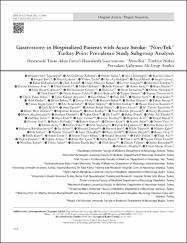Gastrostomy in Hospitalized Patients with Acute Stroke: "NoroTek" Turkey Point Prevalence Study Subgroup Analysis
Citation
Topçuoğlu, Mehmet Akif, et al. "Gastrostomy in Hospitalized Patients with Acute Stroke:" NöroTek" Turkey Point Prevalence Study Subgroup Analysis." Turkish Journal of Neurology/Turk Noroloji Dergisi 28.3 (2022).Abstract
Objective: Nutritional status assessment, dysphagia evaluation and enteral feeding decision are important determinants of prognosis in acute neurovascular diseases. Materials and Methods: NoroTek is a point prevalence study conducted with the participation of 87 hospitals spread across all health sub regions of Turkey conducted on 10-May-2018 (World Stroke Awareness Day). A total of 972 hospitalized neurovascular patients [female: 53%, age: 69 +/- 14; acute ischemic stroke in 845; intracerebral hematoma (ICH) in 119 and post-resuscitation encephalopathy (PRE) in 8] with complete data were included in this sub-study. Results: Gastrostomy was inserted in 10.7% of the patients with ischemic stroke, 10.1% of the patients with ICH and in 50% of the patients with PRE. Independent predictors of percutaneous endoscopic gastrostomy (PEG) administration were The National Institutes of Health Stroke Scale score at admission [exp (ss): 1.09 95% confidence interval (CI): 1.05-1.14, per point] in ischemic stroke; and mechanical ventilation in ischemic [exp (ss): 6.18 (95% CI: 3.16-12.09)] and hemorrhagic strokes [exp (ss): 26.48 (95% CI: 1.36-515.8)]. PEG was found to be a significant negative indicator of favorable (modified Rankin's scale score 0-2) functional outcome [exp (ss): 0.032 (95% CI: 0.004-0.251)] but not of in-hospital mortality [exp (ss): 1.731 (95% CI: 0.785-3.829)]. Nutritional and swallowing assessments were performed in approximately two-thirds of patients. Of the nutritional assessments 69% and 76% of dysphagia assessments were completed within the first 2 days. Tube feeding was performed in 39% of the patients. In 83.5% of them, tube was inserted in the first 2 days; 28% of the patients with feeding tube had PEG later. Conclusion: The NoroTek study provided the first reliable and large-scale data on key quality metrics of nutrition practice in acute stroke in Turkey. In terms of being economical and accurate it makes sense to use the point prevalence method. Amaç: Akut nörovasküler hastalıklarda nütrisyonel durum ve disfaji değerlendirmesi ve enteral beslenme kararı önemli prognoz belirleyicilerindendir.
Gereç ve Yöntem: NöroTek, 10 Mayıs 2018’de (Dünya İnme Farkındalık Günü) Türkiye’nin tüm sağlık alt bölgelerine yayılmış 87 hastanenin katılımıyla
gerçekleştirilen bir nokta prevalans çalışmasıdır. Hastanede yatan ve bu alt çalışma için toplanan verisi tam olan toplam 972 nörovasküler hasta (kadın: %53, yaş:
69±14 yıl; 845’i akut iskemik inme; 119’u intraserebral hematom ve 8’i post-resüsitasyon ensefalopatisi) analiz edildi Bulgular: Gastrostomi iskemik inmeli hastaların %10,7, intraserebral kanamalıların %10,1 ve post-resusitasyon ensefalopatisi olanların %50’sine uygulanmıştır.
Perkütan endoskopik gastrostomi (PEG) gereksiniminin bağımsız belirleyicileri, iskemik inme grubunda kabul NIHSS [exp (β): 1,09, %95 güven aralığı (GA):
1,05-1,14, puan başına] ile hem iskemik hem de hemorajik inmelerde mekanik ventilasyon uygulanmış olmasıdır [iskemik için: exp (β): 6,18, %95 GA: 3,16-
12,09] ve hemorajik inme için: [exp (β): 26,48, 95% GA: 1,36-515,8]. İnme olgularında PEG uygulaması hastane içi mortalite için bağımsız belirleyici değildi
[exp (β): 1,731, 95% GA: 0,785-3,829]. Ancak, PEG uygulanmış olması taburculuk esnasında iyi prognoza (modifiye Rankin skoru 0-2) sahip olabilme için
anlamlı bir negatif etmen olarak bulundu [exp (β): 0,032, %95 GA: 0,004-0,251]. Hastanede yatan nörovasküler hastaların yaklaşık üçte ikisinde malnütrisyon
ve yutma bozukluğu açısından değerlendirme yapılmıştı. Nutrisyonel status değerlendirmesinin %69’u ve disfaji değerlendirmesinin %76’sı ilk 48 saat içinde
gerçekleştirilmişti. Tüple enteral nütrisyon uygulama oranı %39’du. Beslenme tüplerinin %83,5’i ilk 2 gün içinde yerleştirilirken beslenme tüpü olan hastaların
%28’ine daha sonra PEG açılmıştı.
Sonuç: NöroTek çalışması ile Türkiye’de hastanede yatan akut inme hastalarında nutrisyonel uygulamaların temel kalite ölçütlerine ilişkin ilk güvenilir ve büyük
ölçekli veri sağlanmıştır. Ekonomik olması ve doğruluğu açısından nokta yaygınlık yönteminin bu tip verilerin temini için daha fazla kullanılması mantıklıdır.
Source
TURKISH JOURNAL OF NEUROLOGYVolume
28Issue
3URI
https://jag.journalagent.com/tjn/pdfs/TJN_28_3_134_141%5BA%5D.pdfhttps://hdl.handle.net/20.500.12809/10547


















